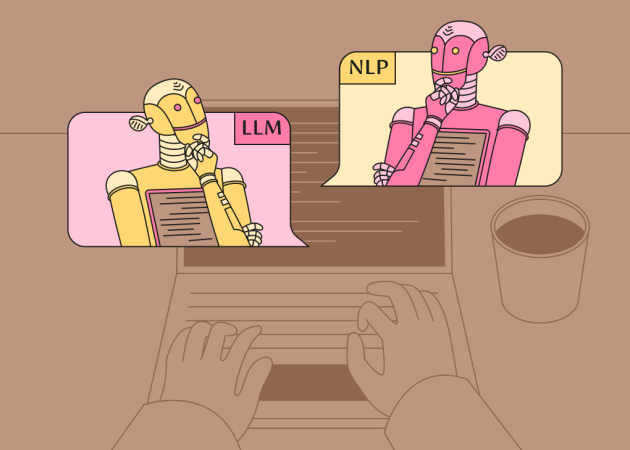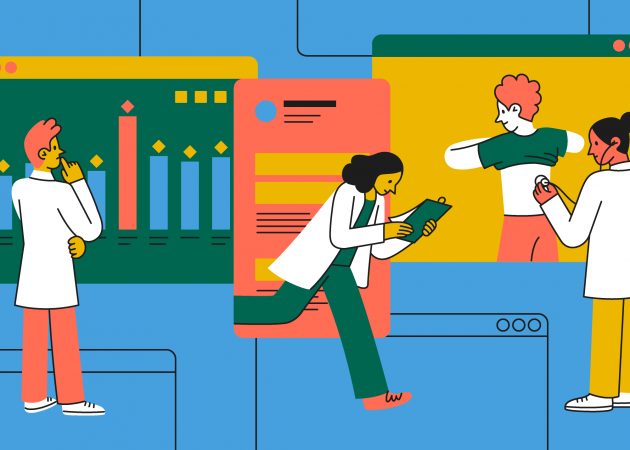
Telehealth App Development Landscape: Today & Tomorrow
Contents
Contents
Intro
When it comes to employing digital technologies and innovation, the healthcare sector has often been referred to as a slow starter.
However, the wake of the pandemic heralded a new era for healthcare software development. Previously seen as more of a concept or optional service, telemedicine solutions reported skyrocketing growth in demand during the last two years.
In its best practices, telemedicine allows patients and clinicians to stay connected from the safety and comfort of their homes, better segregate urgent and non-acute medical care in hospitals, and bridge the gap between what consumers need and what the healthcare system can deliver.
Telemedicine vs. telehealth: a difference in terms of software development
Both telemedicine and telehealth software falls in line with an even broader concept of health information technology. Health IT encompasses all modern computing and engineering solutions, including systems for collecting, storing, sharing, and analyzing health-related data, mobile health applications, connected devices, and more. Health tech also encapsulates other digital technologies, developed initially outside of healthcare but now finding use in this field.
We need to bear in mind that telemedicine is commonly associated with the provision of remote clinical assistance. Telehealth, in turn, refers to a much broader scope of non-clinical healthcare services, including but not limited to remote patient monitoring (RPM), educational systems, pharmacy, real-time communication, health promotion, mobile health, and a plethora of other software solutions.
Lastly, mobile health (or mHealth) apps refer to the concept of self-care and help consumers to capture data about themselves using their smartphones and wearables without clinicians’ assistance or interpretation. They fall into the categories of sports, fitness, nutrition, mental health, and general wellbeing. Healthcare apps are the fastest growing market in global patient-centric health provision, and numbers speak volumes here.
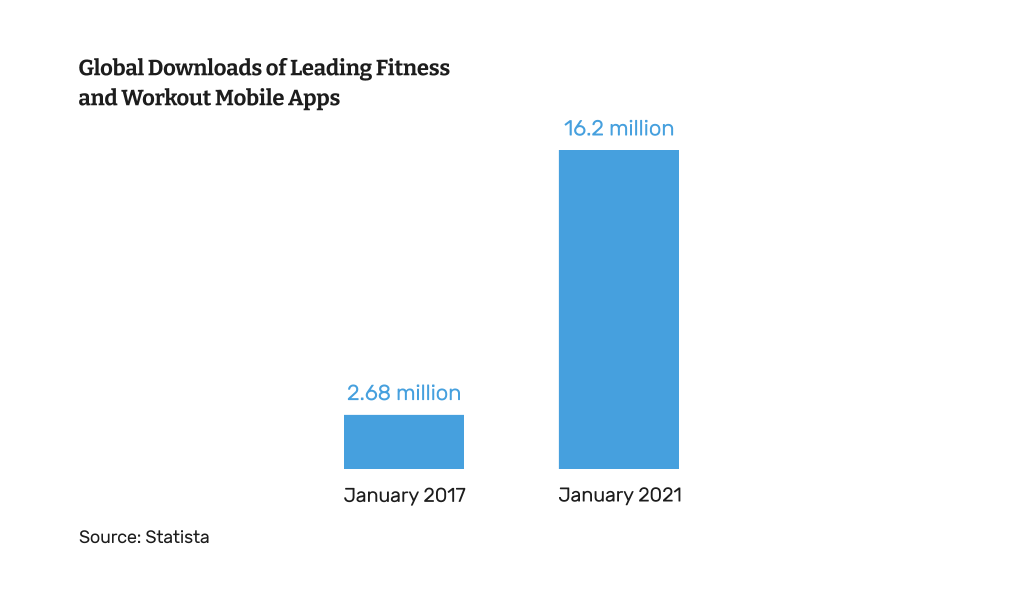
Healthcare app market is growing: key takeaways
According to Grand View Research, the global telemedicine market was estimated at USD 55.9 billion in 2020 and is forecast to reach USD 298.9 billion by 2028. Increasing consumer demand, limited access to traditional care, more widespread adoption of telemedicine among providers, a better quality of care, and patient acceptance are the key drivers of such growth.
Global mHealth apps market volume is estimated to hit USD 149.3 billion by 2028 — from USD 40.05 billion in 2020. Its two main categories encompass medical applications (women’s health, medication management, personal health records, etc.) and lifestyle apps, including nutrition, exercise, mindfulness, and stress management. Given the rapid growth in the mobile devices and wearables market, mHealth app development opens up new horizons for revenue generation, cost reduction, and improved lifestyle and treatment outcomes.
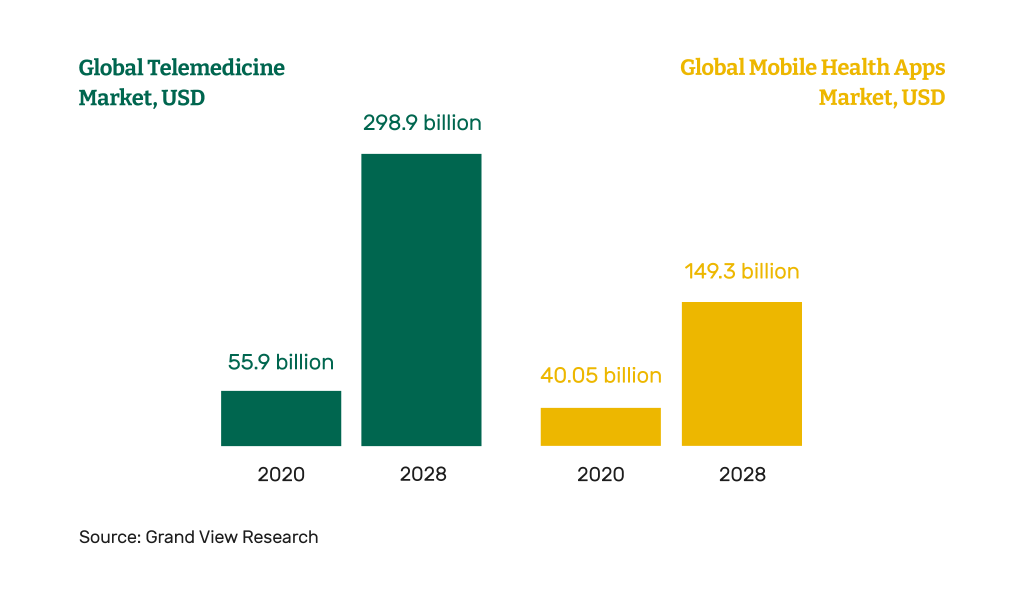
Trending healthcare apps categories in post-pandemic reality
As of Q1, 2021, approximately 54 thousand healthcare apps are available in the Apple App Store and about the same quantity at Google Play. We rounded up some of the most prospective types of applications based on the market trends:
- Real-time services for online doctor consultation and appointment scheduling
The number of virtual doctor appointments skyrocketed in times of lockdowns. One of the top-rated non-emergency care apps is Teladoc, popular with patients and clinics alike. If built correctly, apps can save clinicians and patients incredible amounts of time. All you need is a team of experienced developers who will create a customized solution tailored to your specific requirements and platform preferences.
- Patient data analysis and diagnosis support
Various health-related data, including Electronic Health Records (EHRs), biometrics from wearable devices, and medical imaging, are often accumulated and stored in multiple forms and systems. AI and ML algorithms could leverage data processing and assist in scientific research and data-driven decision-making. For example, our recent project focuses on AI-powered genome interpretation, where machine learning algorithms help read genetic maps and deliver high-quality results through an automated platform.
- Solutions for remote patient monitoring and tracking
This category includes remote symptom checkers and complex platforms for managing chronic conditions like cancer, HIV, diabetes, etc., doctor-patient and patient-patient communication, data exchange, and analytics.
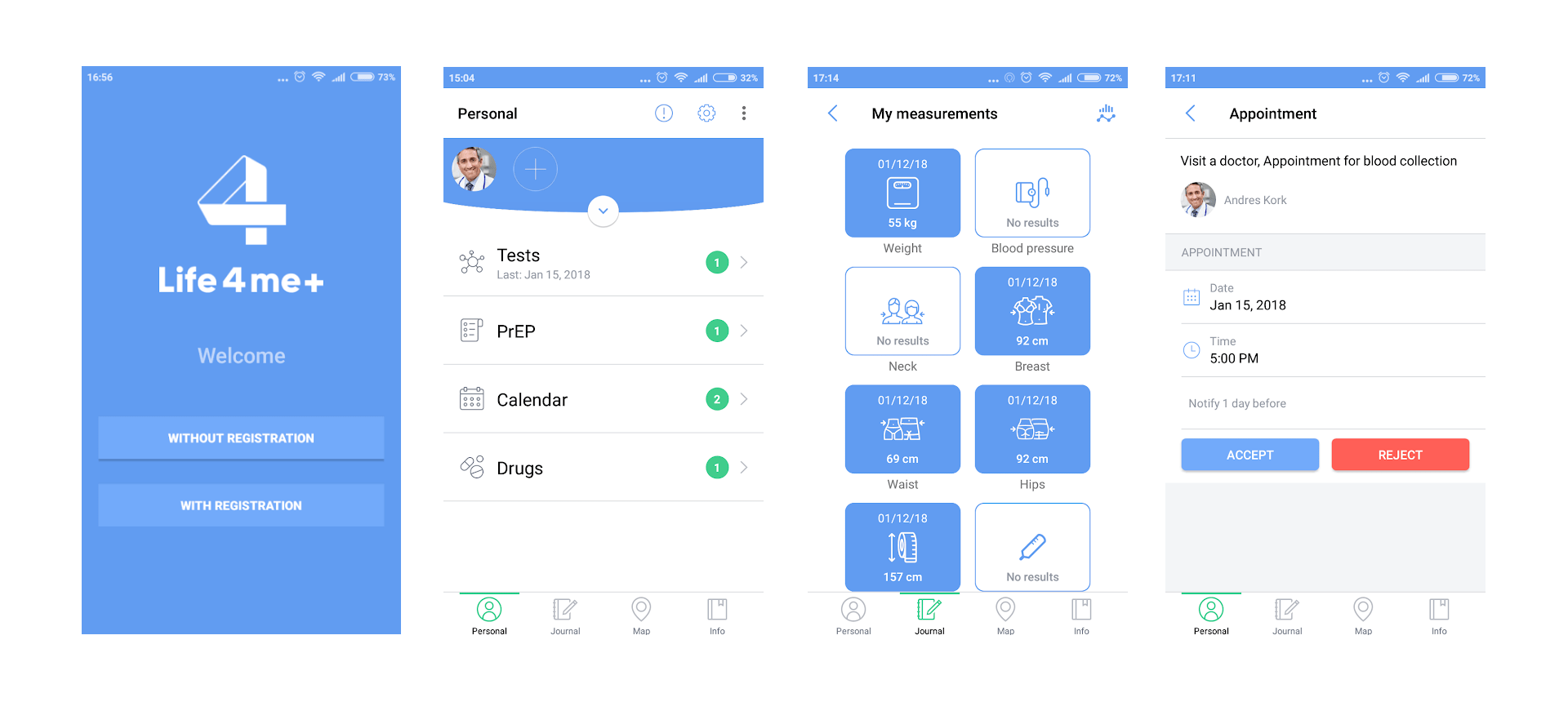
help them connect with their physicians, and assist them during treatment and screenings
- Personal healthcare and wellbeing apps
In this category, you will find an assortment of apps that aim at boosting our everyday wellbeing (mental health, sleep management, meditation apps, fitness, nutrition and diet management, health coaching, etc.). Essentially, these apps allow users to track their habits, set healthier goals and focus on achieving them through various built-in tools and informational support. Check out our Child Nutrition Platform case study as an example.
- Educational healthcare apps
These solutions can vary from medical databases, webinar platforms, medical learning apps of any complexity to fully-fledged educational platforms to deliver digital healthcare training of any scope. Something that our beetiful team of specialists can assist you in creating and bringing into the world.
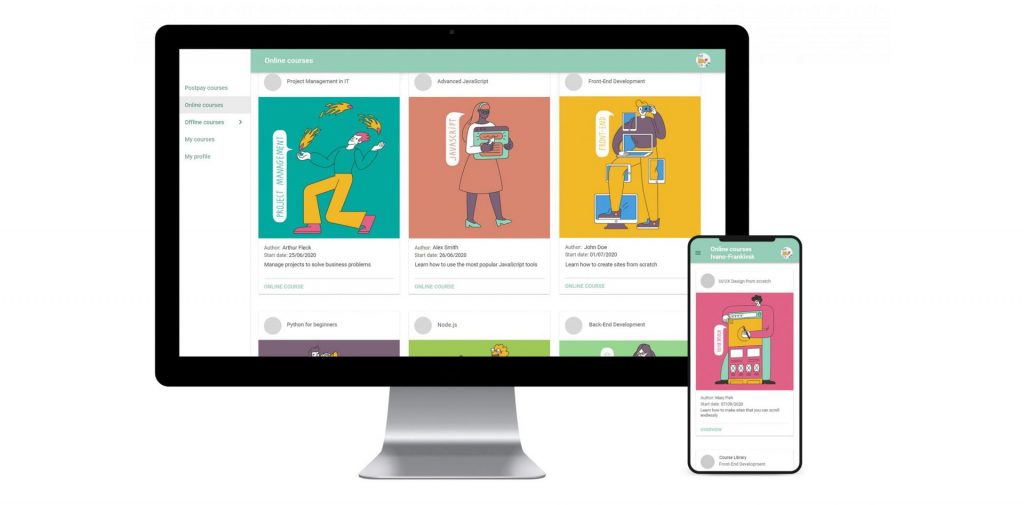
Features that determine an effective mHealth app
What does a healthcare app need to offer to become visible on the market? While there is no universal recipe, below are some key components to consider.
- Seamless UX and non-disruptive UI
A good healthcare app usually looks and feels great. Besides beautiful visualizations, it must provide clear information with actionable steps for all users. Keep in mind that the app design should be simple, logical, and intuitive, oriented to the needs of your specific audience. Not all of them are tech-savvy, so the basic functionality must be easily accessible: from setting up their user profile to booking or changing a doctor’s appointment or viewing dashboards to track their progress or monitor health dynamics.
- Interoperability with IoT devices and wearables
Many people love wearing fitness trackers like Garmin or Fitbit and other smart wearable devices to measure their heart rate, count steps, or calories burned when exercising. Perhaps, your company is developing a proprietary device to capture important vital indicators? A custom program to sync data from a wearable device with a handful of fun and useful features is something your audience might appreciate.
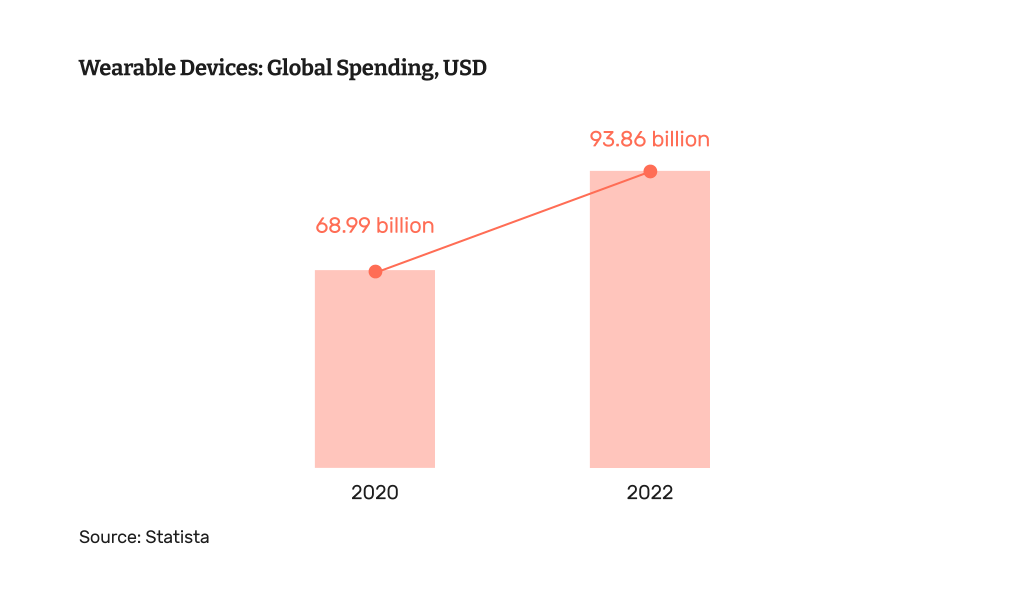
- Built-in communication tools
Real-time communication is the main feature of many telehealth and telemedicine applications. It can be conducted via chat, video-conferencing, or audio calls. During these virtual appointments, patients and doctors need to interact freely, provided with good signal quality at low latency. Session recording, access to community, ratings, and feedback will also be a plus.
- Cross-platform operability
The application must run smoothly on any platform, be it web, iOS, or Android.
- Appointment management
Scheduling and appointment management should allow users to view the list of their appointments, pick the preferred time and date based on doctor availability, edit or cancel appointments at any time. Also, it would be great to use push notifications and reminders to alert patients about their scheduled visits.
- Privacy, security, and compliance
Data security is crucial for healthcare apps since they operate with sensitive patient data that must be encrypted and protected. In relation to medical software, HIPAA compliance means that the application meets the safeguards of the HIPAA Security Rule. In addition, your software might be subject to GDPR, CE, ADA, and other compliance standards — it is desirable to clarify this question before starting the development process.
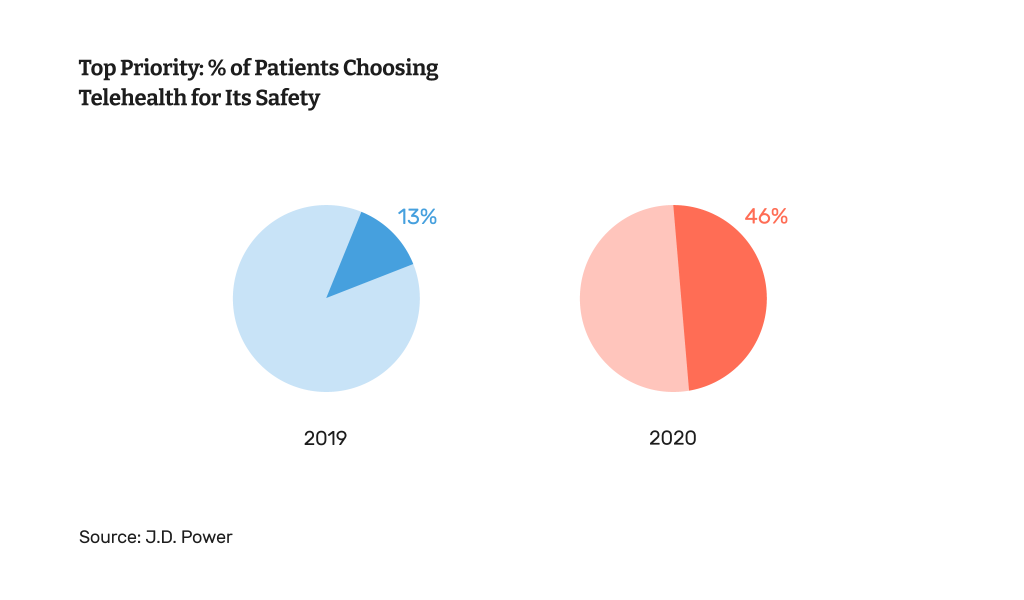
Emerging tech trends in telehealth app development — inspiring ideas for healthcare initiatives
Digital transformation and adoption of advanced technologies such as big data, genomics, and artificial intelligence can help individual healthcare units and larger health ecosystems improve their workflows and deliver a more efficient patient and clinician experience. These trends begin to rule in the healthcare app realm, paving new pathways for original solutions.
- Cloud computing solutions
Healthcare practitioners mostly use cloud computing for communication, patient data maintenance and synchronization, forecasting, and decision-making. Major categories of cloud solutions include software as a service (SaaS), platform as a service (PaaS), and infrastructure as a service (IaaS). Cloud technology reduces the cost of in-house IT infrastructure. In addition, it enables multiple organizations to collectively work on the data hosted and exchanged between secure cloud servers and develop state-of-the-art cloud-based services.
- Big data and artificial intelligence
Clinics and labs accumulate massive volumes of fragmented and unstructured data, ranging from patient diagnosis, treatment results, and medical findings to general facility performance indicators. AI has greatly advanced medical imaging, precision medicine, and diagnostics: ML and CV algorithms can detect patterns and aberrations, otherwise invisible to a human eye. Advanced analytics and algorithm-based decision-making in healthcare hold the potential for reducing treatment costs, predicting outbreaks of epidemics, early screening of a growing number of diseases, introducing modern treatment methods into practice, and improving quality of life in general.
- Blockchain
The reason why blockchain technology is essential is that it has many uses besides crypto exchange. In healthcare, blockchains can be applied to manage electronic medical records (EHRs and EMRs), healthcare data protection, point-of-care genomic management, research, tracing and securing pharmaceutical supplies, insurance claim processing, and much more.
- IoT and wearables
As IDTechEx reports, by 2023, the wearable tech market will hit USD 100 billion. Amongst the latest healthcare IoT developments are glucose trackers (Dexcom, Eversense, Beta Bionics), ECG monitors (Zio XT), sensors for stroke patients, smart contact lenses, even ‘nano noses’ that can detect molecules in the breath that can be a sign of a disease. And there is an enormous potential for the next breakthrough.
- AR/VR
Virtual and augmented reality technologies are still at their early adoption stage in healthcare and medicine. However, this market has the potential to reach USD 2.4 billion by 2026. VR provides medical immersion for various patient needs in aesthetic medicine, orthodontia, ophthalmology, and pain management. It can supplement the rehabilitation of patients who survived brain traumas, strokes, or struggle with post-traumatic stress, neurological conditions, and depression. AR and VR can improve medical training, aid surgeons in their preparation for surgery, and bring 3D imaging and modeling to a new level.
Final thoughts
Healthcare has quickly evolved from a sector that has long resisted digital transformation into a real cauldron of innovation and a promising investment market.
As you can see, the scale of change is enormous. The attitudes towards technology have changed, and so did the approach to service delivery. In this arena, specialized healthcare solutions have transformed how patients access healthcare, receive treatment and interact with their healthcare providers.
Whatever stage of your healthcare-improving project you are in, our team of experts and skilled developers will be happy to assist you on this journey. So let’s get in touch.
Subscribe to blog updates
Get the best new articles in your inbox. Get the lastest content first.
Recent articles from our magazine
Contact Us
Find out how we can help extend your tech team for sustainable growth.




